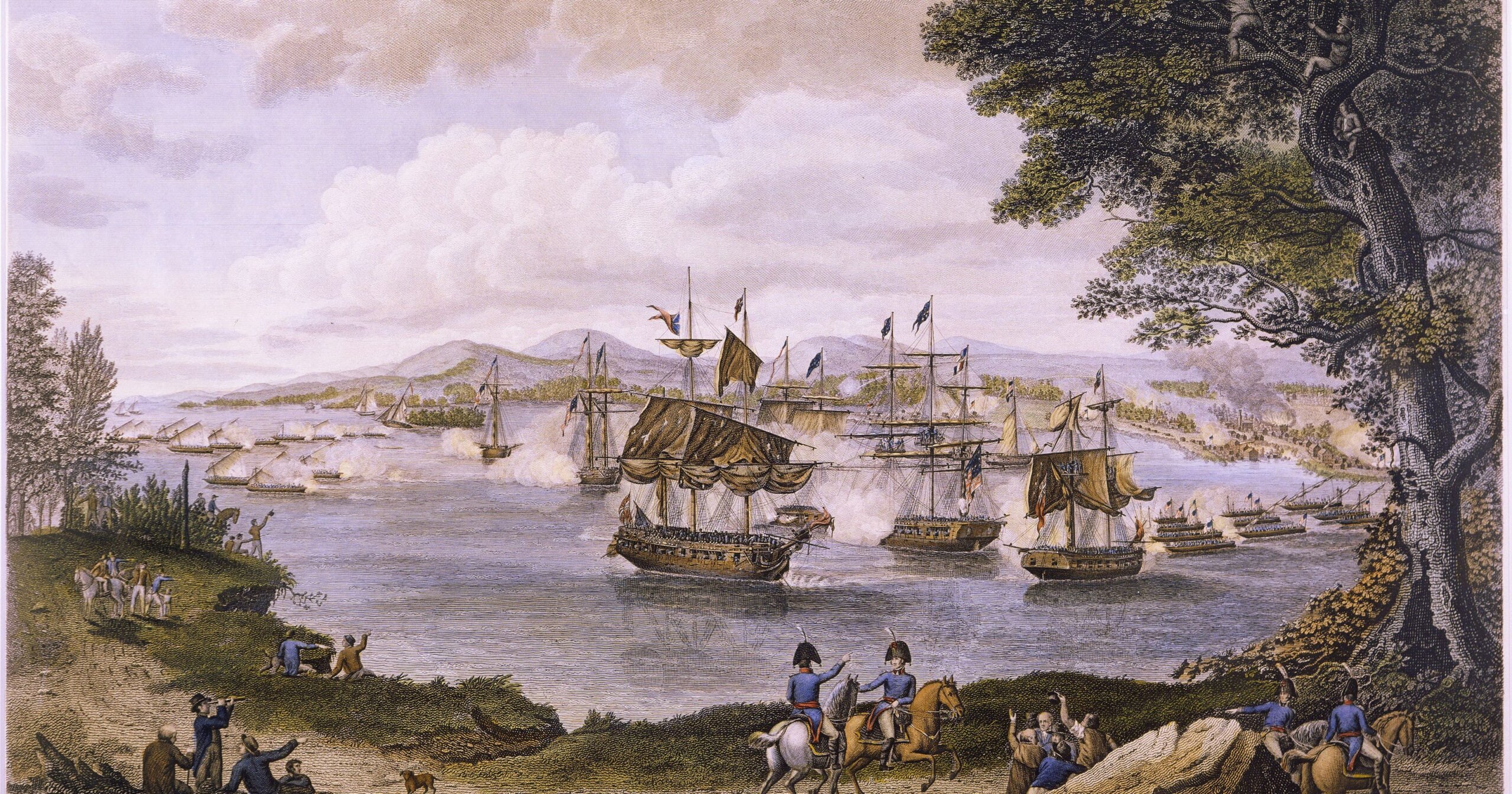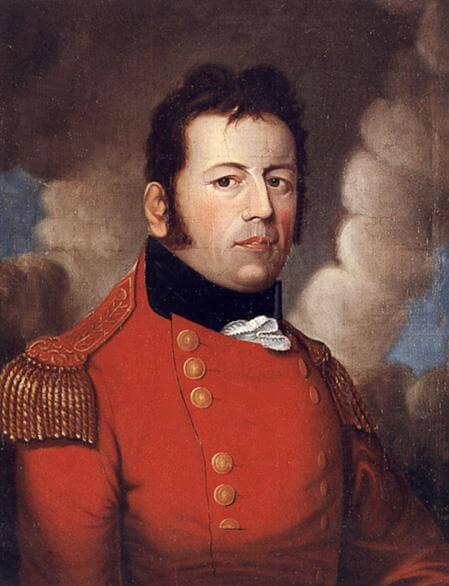
Defeat of the British Army at Plattsburg by General Macomb. [Wikimedia]
This was especially the case on the eastern seaboard where, in one of the conflict’s earliest engagements, HMS Belvidera had evaded the pursuit of three American vessels. The British had then decisively rebuffed a U.S. invasion of Canada at the battles of Crysler’s Farm and Châteauguay in late 1813.
With Napolean subdued—albeit temporarily—in April 1814, Britain had turned its attention to North America by providing sufficient troops for offensives into the United States. Already, the King’s men had begun their invasion of eastern Maine, spearheaded by Nova Scotia Lieutenant Governor John Sherbrooke.
More successful still was Major-General Robert Ross’s landing in Maryland on Aug. 19, 1814. From there, British forces inflicted a crushing defeat on U.S. defenders at the Battle of Bladensburg. Later dubbed “the greatest disgrace ever dealt to American arms,” the engagement paved the way for the capture and burning of Washington. With U.S. government buildings and the Presidential Mansion put to the torch over 26 hours, the British headed for Baltimore.
It was a dark time for the United States, with hopes of capturing Canada having long since faded. Even the most ardent war hawks, including U.S. politician Henry Clay, expressed concern about what lay ahead. “I tremble indeed whenever I take up a late newspaper. Hope alone sustains me,” he wrote.
Meanwhile, U.S.-British negotiations—increasingly favouring the latter over the former—continued in the Belgian city of Ghent. Intent on driving as hard a bargain as possible, it was deemed prudent to launch another offensive into the United States from the north. The objective was to eliminate American power on Lake Champlain, N.Y., before any treaty could be agreed upon and ratified.
British General George Prevost prepared an expedition to seize control of the area just over the U.S. border, south of Montreal. The assaulting force comprised some 10,300 regular soldiers and Canadian militiamen.
The invasion commenced on Sept. 1, 1814, as the men marched along the west shore of Lake Champlain toward Plattsburgh. Joining the fray was a British naval squadron on the lake itself that Prevost deemed crucial to his success.
Travelling via poor roads, their advance frustrated by New York militiamen destroying bridges and engaging in skirmishes, the British land force found itself 13 kilometres from Plattsburg on Sept. 5. The King’s men reached the town the next day only to find it deserted. Nevertheless, it wasn’t long before the U.S. naval squadron bombarded the invaders from Lake Champlain.

Sir George Prevost was Governor General of Canada from 1812-1815. [Wikimedia]
Why, exactly, Prevost ordered his naval squadron into the bay when its strength was in its long-range weaponry remains unknown. The American vessels had the edge at close quarters, a fact that became all too evident on Sept. 11.
Captain George Downie, the British naval squadron commander, brought the new frigate HMS Confiance to within 300 yards of the enemy corvette USS Saratoga. Elsewhere, the 350-ton brig HMS Linnet engaged USS Eagle of the same class. A battle between British and American gunboats added to the cacophony, intensifying further when HMS Finch participated in the struggle alongside the equally matched USS Preble and schooner USS Ticonderoga.
The confrontation unravelled quickly for the invaders. A cannon was knocked loose from its carriage, crushing Downie to death. British ship after British ship was either sunk or damaged beyond effectiveness as the American vessels seized the upper hand. Saratoga, itself damaged, manoeuvred against Confiance, now commanded by Royal Navy Lieutenant James Robertson following Downie’s demise. As the British frigate tried desperately to turn so it could fire, the enemy corvette launched a volley of hand spikes against a cluster of Royal Navy sailors. The immense destruction wrought upon Confiance proved its undoing. Robertson ordered the colours struck and surrendered.
Chaos also found the British on the lake shores, where the column initially advanced in the wrong direction. Despite this, the men ultimately found and assaulted the defenders but then received an unexpected withdrawal order. Those who had pushed too far ahead were forced to lay down their arms.
An ever-cautious Prevost had had the wind knocked out of his sails by the naval defeat. In response, he had issued the command to retire his larger British contingent and retreat to Canada. The U.S. soldiers, bemused by the sudden departure of their would-be attackers, were victorious on land and lake.
Not only did the attack fail to dislodge the well-positioned defenders, but it likewise became one of the greatest land victories for the United States.
Prevost had been unquestionably timid. Having served as civilian governor and military commander-in-chief of the Canadas, he was eventually superseded and recalled to London, England, to answer for his conduct. The 49-year-old general died on Jan. 5, 1816, a mere 10 days before a court-martial hearing where he hoped to clear his name. Prevost never restored his tarnished reputation.
What began at Plattsburg spiralled into a series of unfortunate events for the British. The day after the battle—Sept. 12—Major-General Robert Ross commenced his assault on Baltimore but was killed during the advance. Replaced by a less competent officer, the attack faltered against a stout American defence. Nearby at the besieged Fort McHenry, the defiance displayed from within inspired Francis Scott Key to write a poem entitled ‘The Star-Spangled Banner.’ It later became the American national anthem.
On Jan. 8, 1815, with the Treaty of Ghent signed but not yet ratified by the U.S., British Major-General Edward Pakenham launched an assault on New Orleans. Not only did the attack fail to dislodge the well-positioned defenders, but it likewise became one of the greatest land victories for the United States.
Today, the question of who won the War of 1812 remains a topic of considerable debate. There is, however, broad consensus on who suffered some of the worst hardships: the Indigenous peoples of eastern North America.
Advertisement





















